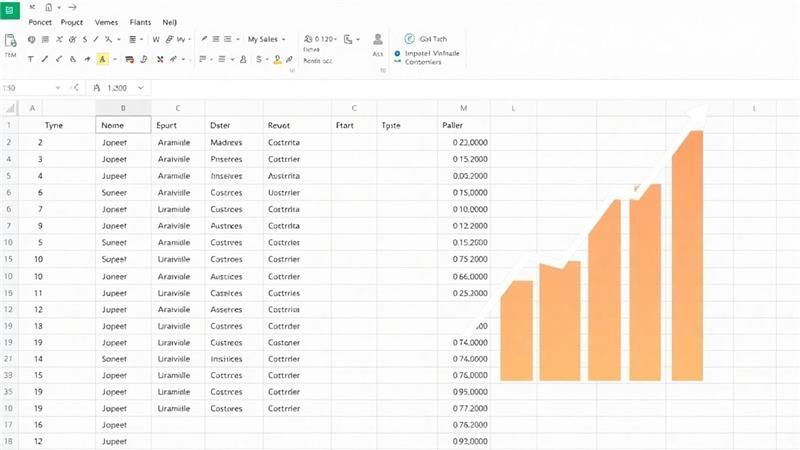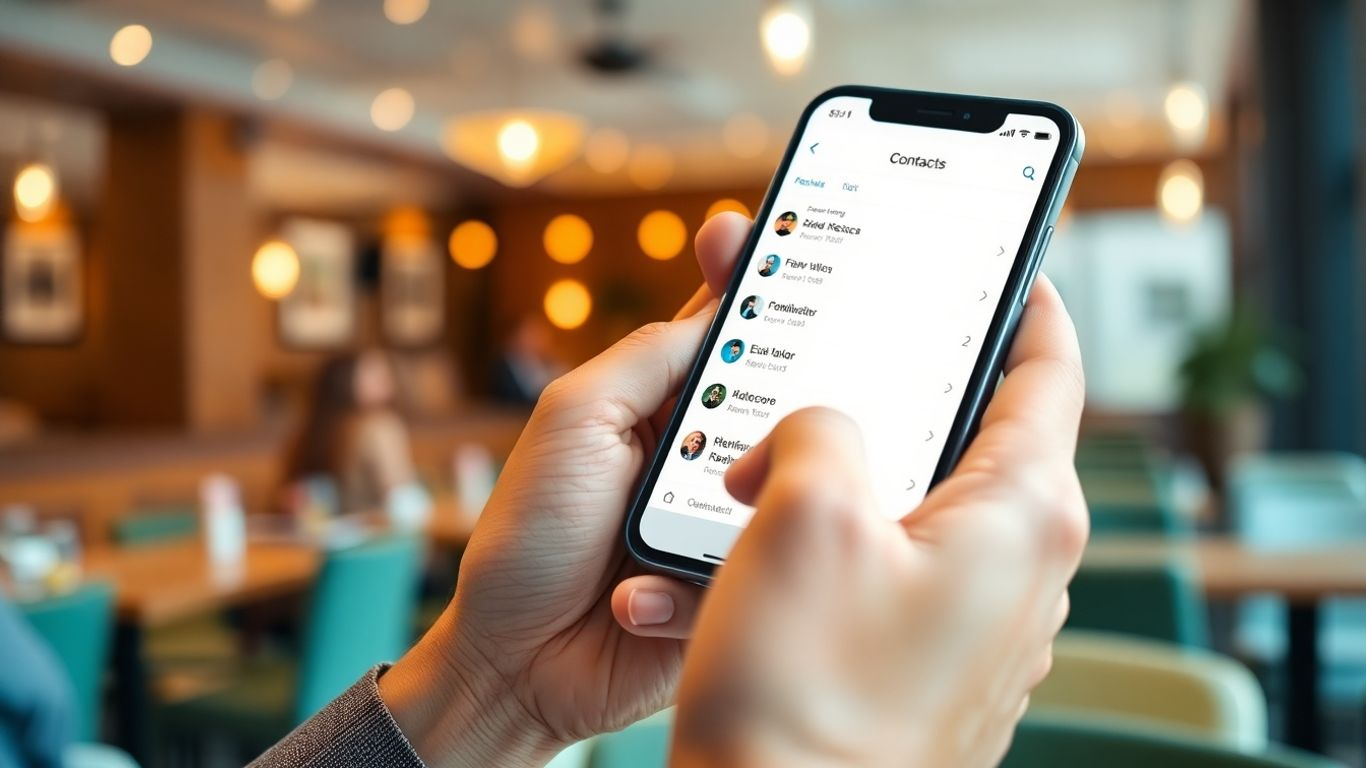Expanding Beyond Borders: How USA Restaurant Databases Drive Growth
Blog Author - Published Date
So, you've got a bunch of restaurant contacts, maybe from sign-ups, events, or past marketing efforts. That's great! But just having a list isn't enough. To really make those contacts work for you, you need to get them into your CRM and make sure they're clean and organized. This guide will walk you through how to take your restaurant contact database, get it ready, and use it to grow your business. We'll cover everything from importing that CSV file to making sure your outreach hits the mark.
Key Takeaways
- A good restaurant database helps you understand your customers and reach them effectively.
- Always get contacts' permission before adding them to your marketing lists.
- Using CSV files makes importing your restaurant data into a CRM simple.
- Keeping your contact information clean and up-to-date is key for successful campaigns.
- Segmenting your restaurant database lets you send more targeted and relevant messages.
Leveraging Your Restaurant Database for Growth

Building a strong restaurant business today means more than just serving great food. It's about connecting with your customers, understanding what they want, and making sure they keep coming back. A well-managed contact list is your secret weapon for this. Think of it as your direct line to the people who love your food and your brand.
Understanding the Value of a Verified Restaurant Database
Having a list of restaurant contacts is one thing, but having a verified list is what really makes a difference. This isn't just a collection of emails and phone numbers; it's a curated group of people who have shown interest in your business or similar ones. When you have accurate, up-to-date information, you can actually reach the right people. This means fewer bounced emails, fewer wrong numbers, and more successful outreach. It’s about quality over quantity, making sure your marketing efforts don’t go to waste on contacts who aren’t interested or can’t be reached.
Key Features of a High-Quality Restaurant Database
What makes a restaurant database truly useful? For starters, it needs to be current. Data gets old fast in the restaurant world, so regular updates are a must. We're talking about information that's checked and refreshed often, maybe every few months. Then there's the source of the data. Ideally, these contacts have given permission to be contacted – they've opted in. This makes a huge difference in how receptive they are to your messages. The data should also be easy to work with, like in a simple CSV file that you can easily import into your customer relationship management (CRM) system. Having details like job titles, restaurant type, or location can also help you tailor your messages. A good database should also be compliant with privacy laws, so you don't have to worry about legal issues.
Here’s a quick look at what to expect:
- Accuracy: Verified and regularly updated contact details.
- Permission: Contacts who have opted-in to receive communications.
- Usability: Data formatted for easy import into CRMs.
- Compliance: Adherence to privacy regulations like GDPR and CCPA.
- Detail: Rich information for effective segmentation.
Building Trust with Opt-In Restaurant Contacts
When you build your contact list by asking people to sign up, you're starting off on the right foot. It shows respect for their privacy and their inbox. People who opt-in are generally more interested and more likely to engage with your marketing. This isn't just about getting a sale; it's about building a relationship. Think about it: would you rather get an email from someone you asked to contact you, or someone who just added you to their list without asking? It’s a big difference. This approach helps create a positive brand image and leads to better results over time. You can find out more about choosing the right restaurant CRM systems that can help manage these relationships effectively.
Acquiring and Preparing Your Restaurant Contact List

Getting the right contacts is the first step to growing your restaurant business. You need a solid list of people who are actually interested in what you have to offer. This means finding reliable sources for your restaurant email list and making sure the data is clean and usable.
Sourcing Your Restaurant Database
Finding good data can feel like searching for a needle in a haystack. You want to connect with people who are likely to be interested in your products or services. This often means looking for lists that are built on opt-in methods, meaning people have given permission to be contacted. A well-sourced list is the foundation of any successful outreach. Think about where you're getting your restaurant information. Are you collecting emails from your own website, from industry events, or perhaps purchasing a curated list? Each method has its pros and cons. For instance, building your own list takes time but often yields higher quality leads. Purchasing lists can be faster, but you need to be very careful about the source to avoid bad data or compliance issues. When looking for restaurant owners email addresses, prioritize sources that can show you how they collected their data and that it's up-to-date.
Choosing the Right Data Format for Import
Once you have your list, you need to make sure it's in a format your CRM can understand. Most CRMs work well with Comma Separated Values (.csv) files. This format is pretty standard and easy to work with. Other common formats include Excel (.xls or .xlsx) or even plain text (.txt) files. The key is consistency. If your data is all over the place, it will be a headache to import. Look for data providers that offer flexibility in their export formats. This way, you can choose what works best for your existing systems. Having your data ready in a .csv file makes the import process much smoother.
Ensuring Data Accuracy and Compliance
This is a big one. Having outdated or incorrect information is worse than having no information at all. It wastes your time and can even damage your reputation. Make sure your contacts are current and that you have permission to contact them. This means adhering to regulations like GDPR and CCPA. Always check that your data provider is compliant with privacy laws.
Here are some key things to look for:
- Verification: Is the data regularly checked for accuracy?
- Opt-in Status: Have the contacts agreed to receive communications?
- Data Freshness: How often is the list updated?
- Compliance: Does the provider follow data privacy rules like GDPR and CCPA?
Working with accurate and compliant data isn't just good practice; it's a legal requirement. It protects your business and builds trust with your audience. You can find resources on effective restaurant marketing strategies to help guide your outreach efforts.
When you're looking for restaurant owners email addresses, ask about their data validation process. A good provider will be transparent about how they maintain their lists. This diligence upfront saves a lot of trouble down the road and helps you focus on building relationships, not fixing bad data. You can explore options for a free sample list to test the quality before committing to a larger purchase.
Importing Your Restaurant Data into Your CRM
So, you've got your restaurant contact list, probably in a nice, clean CSV file. That's great! Now comes the part where you actually use it. Getting your restaurant contacts into your CRM is the next big step. It’s not super complicated, but you want to do it right so your data is actually useful.
Seamless CRM Integration for Restaurant Contacts
Think of your CRM as the central hub for all your customer interactions. When you import restaurant contacts, you're essentially feeding this hub with valuable information. Most CRMs are built to handle data imports, especially from common formats like CSV. The goal is to make this process as smooth as possible so you can start using the data quickly. You're not just dumping names and emails; you're bringing in potential leads and existing customer information that can help you grow your business. The key is to ensure the data you're importing is compatible with your CRM's structure.
Best Practices for CSV Import
When you import restaurant contacts to CRM, there are a few things to keep in mind. First, make sure your CSV file is organized. Each column should represent a specific piece of information, like 'First Name', 'Last Name', 'Email', 'Phone Number', 'Restaurant Name', and 'Job Title'.
Here’s a quick checklist:
- Header Row: Always include a header row with clear labels for each column. This helps your CRM understand what each piece of data is.
- Data Formatting: Check that your data is formatted correctly. For example, phone numbers should be in a consistent format, and email addresses should be valid.
- Duplicate Check: Most CRMs have a way to check for and handle duplicate entries during the import process. Use this feature to keep your database clean from the start.
- Mapping Fields: During the import, you'll usually need to map the columns in your CSV file to the corresponding fields in your CRM. Take your time with this step to avoid errors.
Importing data isn't just about getting it into the system; it's about making it usable. A well-organized import means your CRM can accurately segment, track, and communicate with your contacts.
Utilizing Data for Targeted Outreach
Once your restaurant contacts are in your CRM, the real magic happens. You can start using this data to send out targeted messages. Instead of sending a generic email to everyone, you can segment your list based on criteria like restaurant type, location, or even past interactions. For instance, if you have a new marketing service for Italian restaurants, you can easily pull up all your contacts who own or manage Italian eateries and send them a tailored message. This kind of personalization makes your outreach much more effective and shows your contacts that you understand their specific needs. It’s all about making your marketing efforts count.
Cleaning and Optimizing Your Restaurant Contact List
So, you've got your restaurant contact list CSV all ready to go. That's great! But before you start sending out emails or making calls, we need to talk about making sure that list is actually useful. Think of it like prepping ingredients before you cook; you wouldn't just throw everything in the pot, right? Same idea here.
The Importance of Data Hygiene
Having clean data is super important. If your list is full of old addresses, wrong phone numbers, or duplicate entries, your messages aren't going to reach the right people. This can really hurt your campaign results and make you look unprofessional. Keeping your data tidy means your outreach efforts are more likely to hit the mark. It's all about making sure you're talking to actual, interested people.
Strategies for Data Normalization
Data normalization is basically about making sure all your information is in a consistent format. This means things like:
- Standardizing Addresses: Making sure street names, states, and zip codes are written the same way every time. No more 'St.' vs. 'Street' confusion.
- Formatting Phone Numbers: Getting all phone numbers into a single, recognizable pattern, like (XXX) XXX-XXXX.
- Cleaning Up Names: Fixing typos and making sure first and last names are in the correct fields.
- Removing Duplicates: Finding and getting rid of any contacts that appear more than once on your list.
Segmenting Your Restaurant Database Effectively
Once your data is clean, you can start to group your contacts. This is called segmentation, and it's a game-changer. Instead of sending the same message to everyone, you can tailor your communication based on what you know about them. For example, you might segment your list by:
- Restaurant Type: Fine dining, casual, fast food, cafes, etc.
- Location: Specific cities, neighborhoods, or regions.
- Job Role: Owners, managers, chefs, marketing staff.
- Past Engagement: Customers who have ordered before, those who have attended events, or those who haven't interacted recently.
Segmenting allows you to send more relevant messages. When people get emails or offers that actually speak to their specific needs or interests, they're much more likely to pay attention and respond positively. It makes your marketing feel less like spam and more like helpful information.
Maximizing Campaign Success with Your Restaurant Database
So, you've got this list of restaurant contacts, all cleaned up and ready to go. That's awesome. But what do you actually do with it? It's not just about having the data; it's about using it smart. Think of it like having a bunch of ingredients – you need a good recipe to make something tasty.
Personalizing Outreach with Segmented Data
This is where breaking down your list really pays off. Sending the same message to everyone? That's a quick way to get ignored. Instead, look at what you know about your contacts. Are they a small cafe owner in a busy downtown area, or a manager at a large chain restaurant out in the suburbs? Do they specialize in Italian food, or are they more into vegan options?
- Job Title: Are you talking to the owner, the head chef, or the marketing manager? Their priorities are different.
- Restaurant Type: Fine dining, fast casual, food truck – they all have unique needs.
- Location: Urban vs. rural, or even specific neighborhoods, can influence their business.
- Services Offered: Do they do catering? Delivery? Takeout only?
By segmenting your list based on these details, you can tailor your message. Imagine sending a special offer on bulk coffee beans to a cafe that serves breakfast, versus a discount on wine glasses to a place that focuses on dinner service. It just makes sense, right? This targeted approach shows you've done your homework and understand their business.
Improving Engagement Through List Management
Keeping your list healthy is an ongoing thing. It's not a 'set it and forget it' deal. People change jobs, restaurants close, and email addresses get old.
- Regular Cleaning: Set a schedule, maybe quarterly, to go through your list. Remove contacts that bounce back consistently or who haven't opened your emails in ages. It keeps your sender reputation good.
- Re-engagement Campaigns: For contacts who've gone quiet, try a special campaign to win them back. Something like, 'We miss you! Here's a special offer.' If they don't bite, it's probably time to let them go.
- Preference Centers: Let people tell you what kind of emails they want to receive and how often. This reduces unsubscribes and keeps people engaged with content they actually care about.
Think of your email list like a garden. You need to water it, pull out the weeds, and make sure the right plants are getting sunlight. If you just let it go, it won't produce anything good.
Tracking Performance and ROI
How do you know if any of this is working? You track it. Look at your open rates, click-through rates, and, most importantly, what happens after they click. Did they visit your website? Did they make a purchase? Did they book a demo?
Here’s a simple way to look at it:
| Metric | What it Tells You |
|---|---|
| Open Rate | How many people are seeing your subject line. |
| Click-Through Rate | How many people are interested enough to click. |
| Conversion Rate | How many people took the desired action. |
| ROI | How much money you made versus how much you spent. |
By watching these numbers, you can see which segments are responding best, which messages are hitting the mark, and where you might need to adjust your strategy. It’s all about learning and getting better with every campaign you send out.
Expanding Your Reach with a Global Restaurant Database
So, you've got your local restaurant contacts sorted, maybe even a solid USA restaurant database. That's great for domestic growth, but what about looking beyond your borders? Tapping into international markets can really open up new avenues for your business. It’s not as complicated as it might sound, especially when you have the right data.
Accessing International Restaurant Contacts
Getting your hands on contact information for restaurants in other countries is the first step. Think about what kind of restaurants you want to reach. Are you looking for fine dining in Paris, street food vendors in Tokyo, or cafes in Sydney? Having a clear idea helps narrow down your search. You can find providers who specialize in global B2B data, offering lists that are segmented by country, region, and even specific cities. This kind of targeted approach means you're not just buying a massive, unmanageable list; you're getting data that's relevant to your expansion plans. It’s about quality over sheer quantity, really.
Navigating Data Privacy Regulations
This is a big one. Every country has its own rules about how you can collect and use personal and business contact information. For instance, GDPR in Europe is quite strict. You absolutely need to make sure your data sources are compliant. This usually means the contacts should have opted-in to receive communications. Buying lists where people haven't agreed to be contacted is a fast track to getting your emails flagged as spam or even facing legal trouble. Always check the compliance standards of your data provider. It’s better to be safe than sorry, and frankly, it builds more trust with your potential contacts too. You can find resources that explain these regulations, helping you understand what's required for different regions.
Customizing Your Restaurant Database Filters
Once you have access to international data, the real work of refining it begins. Just like with your domestic lists, you'll want to use filters to get specific. Think about:
- Cuisine Type: Are you targeting Italian restaurants or looking for vegan spots?
- Restaurant Size: Do you want to connect with small independent places or larger chains?
- Services Offered: Are you interested in restaurants that offer delivery, catering, or fine dining experiences?
- Job Titles: Who are you trying to reach? Owners, managers, or marketing directors?
Using these filters helps you create highly targeted lists for your outreach campaigns. For example, if you're promoting a new POS system, you might filter for restaurants that don't currently use one or are in a specific size category. This level of detail is what makes your marketing efforts actually work. It’s about making sure your message gets to the right people, in the right places, at the right time. Having a robust CRM system that can handle this kind of segmentation is key to managing your global outreach effectively. You can explore restaurant CRM solutions to see how they manage diverse contact lists.
Expanding globally means understanding that 'one size fits all' doesn't apply. Each market has its own nuances, and your data strategy needs to reflect that. Being meticulous with your data and respecting local regulations will set you up for success, not just in reaching new customers, but in building lasting relationships across different cultures.
Putting Your Restaurant Contacts to Work
So, you've got your restaurant contact list, cleaned it up, and maybe even imported it into your CRM. That’s a huge step! Having good data is like having a map for your sales and marketing efforts. It means you can actually reach the right people, whether you're trying to introduce a new service or just keep in touch. Remember, keeping that list updated and organized is key. It’s not a one-and-done thing. Think of it as an ongoing process to make sure your outreach hits the mark every time. With a solid contact list and a system to manage it, you’re much better equipped to connect with potential clients and grow your business. It really makes a difference when you know who you're talking to and why.
Frequently Asked Questions
What is a restaurant contact list and why is it important?
A restaurant contact list is a collection of information about people who work in or are associated with restaurants. Think of it like a phone book, but for business contacts. Having a good list helps you connect with the right people to grow your business, whether you're selling them something or trying to reach them for other reasons. It's like having a direct line to potential partners or customers in the restaurant world.
How do I get a good restaurant contact list?
You can build your own list by collecting contact information from people who willingly give it to you, like through website sign-ups or event registrations. It's super important that people agree to be contacted. Avoid buying lists that people haven't signed up for, as this can cause problems and annoy people. Some companies offer pre-made, verified lists, which can be a good starting point if they follow privacy rules.
What does 'verified' mean for a contact list?
A 'verified' contact list means that the information, like email addresses and phone numbers, has been checked to make sure it's accurate and up-to-date. This is really important because using old or wrong information means your messages won't reach the right people, wasting your time and effort. Verified lists are refreshed often to stay current.
What is a CSV file and why is it used for contact lists?
CSV stands for Comma Separated Values. It's a simple file format that looks like a spreadsheet, where each piece of information is separated by a comma. Most computer programs, especially Customer Relationship Management (CRM) software, can easily read and understand CSV files. This makes it simple to move your contact list from one place to another, like importing it into your CRM.
What is CRM and why should I import my restaurant list into one?
CRM stands for Customer Relationship Management. It's a type of software that helps businesses keep track of their interactions with customers and potential customers. By importing your restaurant contact list into a CRM, you can organize all your contacts in one place, track who you've contacted, what you've talked about, and plan your next steps. It makes managing relationships much easier and more effective.
What does 'data cleaning' mean for a contact list?
Data cleaning is like tidying up your contact list. It means fixing mistakes, removing duplicates (like the same contact listed twice), updating old information, and making sure all the data is in the same format. A clean list helps your messages get delivered correctly and ensures you're only contacting the right people, making your marketing efforts much more successful.














